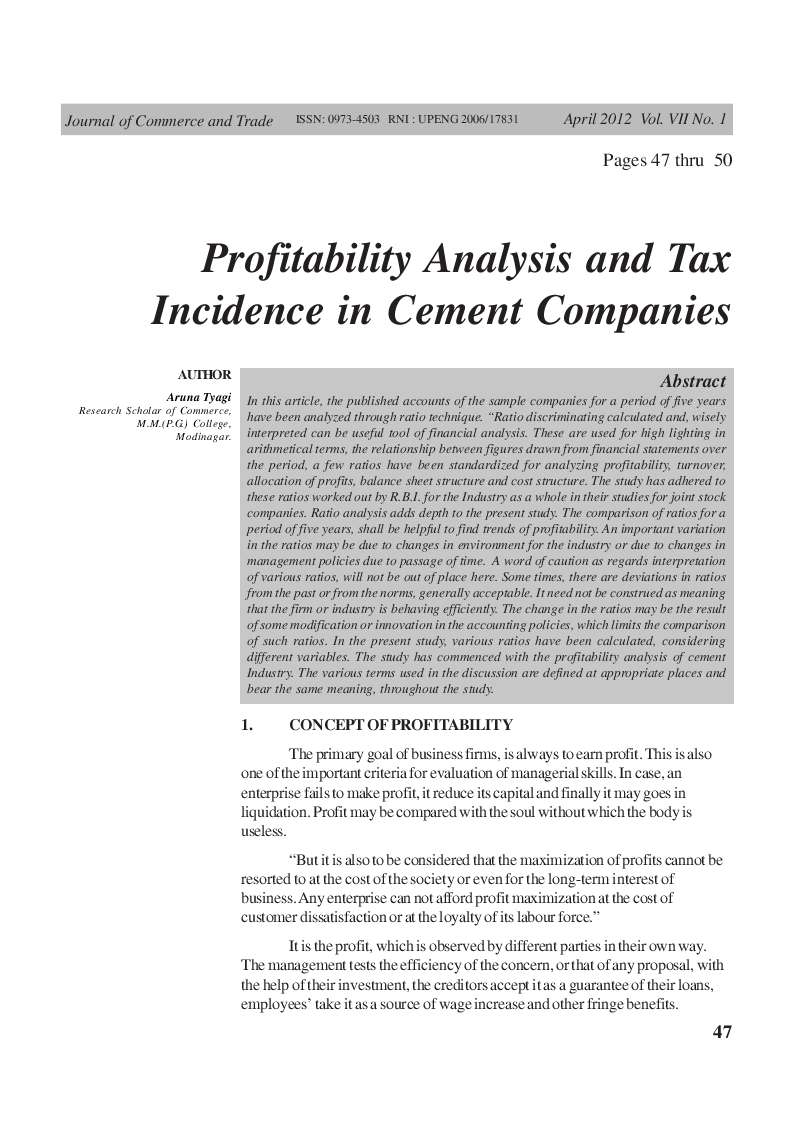Profitability Analysis and Tax Incidence in Cement Companies
DOI:
https://doi.org/10.26703/jct.v7i1.315Keywords:
Profitability Analysis, Tax Incidence, Cement CompaniesAbstract
In this article, the published accounts of the sample companies for a period of five years have been analyzed through ratio technique. These are used for high lighting in arithmetical terms, the relationship between figures drawn from financial statements over the period, a few ratios have been standardized for analyzing profitability, turnover, allocation of profits, balance sheet structure and cost structure. The study has adhered to these ratios worked out by R.B.I. for the Industry as a whole in their studies for joint stock companies. Ratio analysis adds depth to the present study. The comparison of ratios for a period of five years, shall be helpful to find trends of profitability. An important variation in the ratios may be due to changes in environment for the industry or due to changes in management policies due to passage of time. A word of caution as regards interpretation of various ratios, will not be out of place here. Some times, there are deviations in ratios from the past or from the norms, generally acceptable. The change in the ratios may be the result of some modification or innovation in the accounting policies, which limits the comparison of such ratios. In the present study, various ratios have been calculated, considering different variables. The study has commenced with the profitability analysis of cement Industry. The various terms used in the discussion are defined at appropriate places and bear the same meaning, throughout the study.
Downloads
Metrics
References
Agrawal, A., and G.N. Mandelker (2007), Managerial Incentives and Corporate Investment and Financing Decisions, Journal of Finance, 42, 823-837.
Aoki, M. (1990), Towards an Economic Model of the Japanese Firm, Journal of Economic Literature, 28, 1-27.
Balakrishnan, S., and I. Fox (2003), Asset Specificity, Firm Heterogenity, and Capital-Structure, Strategic Management Journa, 14, 3-16.
Balasubramaniam, N. (2005), Corporate Financial Policies and Shareholders Returns: The Indian Experience, (Bombay: Himalaya).
Barney, J.B. (1986), Review of Economic Behavior within Organizations, Administrative Science Quarterly, 31, 140-142.
Barton, S.L., and P.3. Gordon (1997), Corporate Strategy: Useful Perspective for the Study of Capital-Structure, Academy of Management Review, 12, 67-75.
Bhole L.M., Financial Markets & Institutions, New Delhi; Tata McGraw Hill Publishing Company, 1982.
Blazenko, G.W. (2007), Managerial Preference, Asymmetric Information and Financial Structure, Journal of Finance, 42, 839-862.
Bothwell, J.L. (2006), Profitability, Risk and the Seperation of Ownership from Control, Journal of Industrial Economics, 28, 303-312.

Downloads
Published
How to Cite
Issue
Section
License
Copyright (c) 2012 Aruna Tyagi

This work is licensed under a Creative Commons Attribution 4.0 International License.














